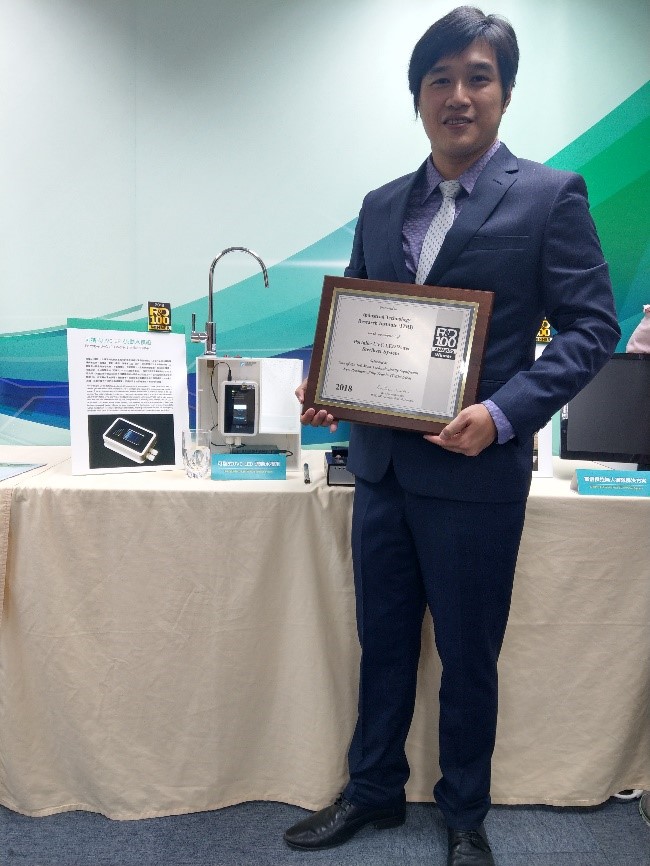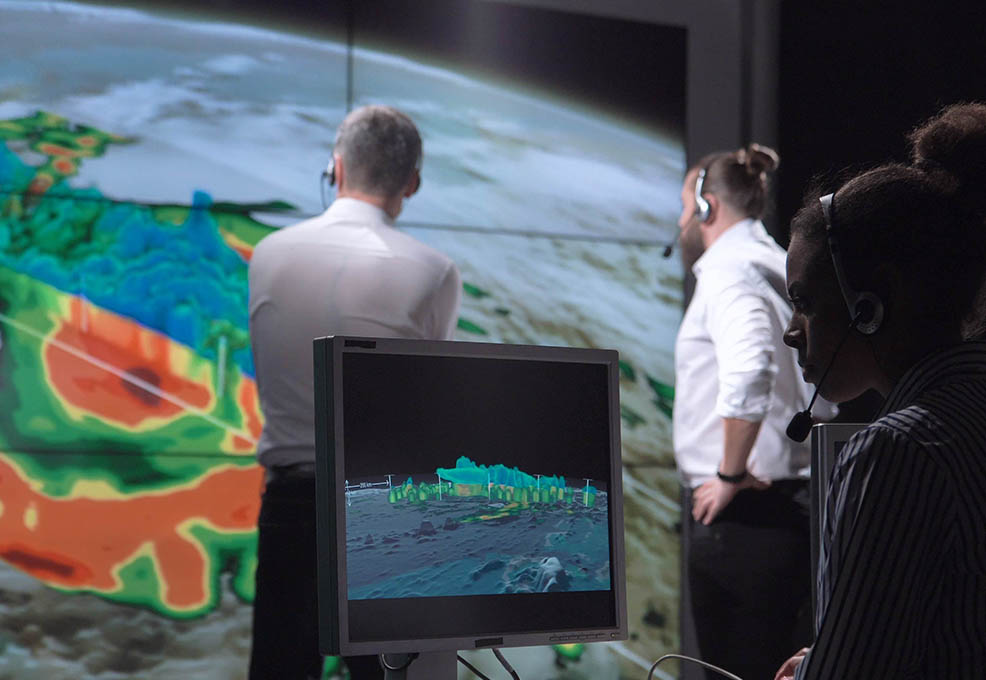Taiwan's Elite AI Projects Are Ready!

Author(s)
Yi-Keng FuBiography
Y. K. Fu received his PhD degree from the Department of Optics and Photonics, National Central University, Jung-Li, Taiwan, in 2010. He is currently with the Opto-Electronics Micro Device & System Application Division, Industrial Technology Research Institute, Hsinchu, Taiwan, as a Deputy Division Director. His current research interests include epitaxial growth and characterization of III-V compound semiconductors, and optoelectronics device fabrication and characterization. To date, he has published 20 SCI/EI papers in international journals, and obtained 33 patents and three R&D100 awards.
Academy/University/Organization
Industrial Technology Research InstituteSource
R&100 Award 2018: Portable UVC LED Water Sterilizer System-
TAGS
-
Share this article
You are free to share this article under the Attribution 4.0 International license
- ENGINEERING & TECHNOLOGIES
- Text & Image
- April 14,2021
Compound semiconductors are components for light emission, sensing, power electronics, and microwave communication. They enable the creation of new applications including smart phones, 5G communication, self-driving cars, and augmented reality and virtual reality monitors. Current techniques continue to rely on mercury-vapor lamps to generate UVC rays. However, over 140 countries signed the Minamata Convention on Mercury, and the manufacture, import, and export of products containing mercury have been prohibited since 2020. Deep ultraviolet (UVC) rays can directly destroy DNA and RNA bonds in bacteria and viruses. Deep ultraviolet light-emitting diodes (LEDs) offering environmental protection and energy conservation are the next major focus of research and development for international optoelectronic companies.
However, UVC LED component technology in Taiwan is far behind that of large international companies, resulting in the difficulty of acquiring efficient UVC LED components in Taiwan, in turn limiting the applications of different types of modules and products. Supported by the Ministry of Economic Affairs (MOEA), ITRI built up the R&D and trial production platform for the development of UVC LED devices and products. We overcame the bottlenecks of UVC LED efficiency, improved the LED output power and developed seven products for the disinfection of water, air, and object surfaces, contributing to the transformation and accelerated research and development of optoelectronic companies, traditional industries, and hospitals. Moreover, investment risk in the industry was reduced, and an upstream, midstream, and downstream UVC LED industry chain in Taiwan was successfully constructed. The government’s talent cultivation program was also integrated to train practical talents in industry.
The development of semiconductor materials started with silicon (Si) in the first generation and gallium arsenide (GaAs) in the second, to wide-bandgap compound semiconductors in the current, third generation. These compound semiconductors are components for light emission, sensing, power electronics, and microwave communication, and have enabled the creation of new applications including smart phones, 5G communication, self-driving cars, and augmented reality and virtual reality monitors. Compound semiconductors are viewed by different countries as the development focus of strategic materials following Si semiconductors.
The Black Death in 1350, SARS in 2002, and COVID-19 in 2020 are just some examples of the ubiquity of life-threatening sources of infection. Deep ultraviolet (UVC) rays can directly destroy DNA and RNA bonds in bacteria and viruses. This physical disinfection mechanism has no chemical agent residue and can be extensively applied in people’s lives for safety and health protection. However, current techniques continue to rely on mercury-vapor lamps to generate UVC rays. Such lamps are large and fragile, and they involve mercury pollution problems and environmental hazards. Consequently, over 140 countries signed the Minamata Convention on Mercury, and the manufacture, import, and export of products containing mercury have been prohibited since 2020. Compound semiconductors have the characteristics of high efficiency and adjustable wavelength. Deep ultraviolet light-emitting diodes (LEDs) offering environmental protection and energy conservation are the next major focus of research and development for international optoelectronic companies.
Taiwan has a complete LED industry chain and international competitiveness in red light to near ultraviolet light (365 nm) components and modules. However, UVC LED component technology in Taiwan is far behind that of large international companies, resulting in the difficulty of acquiring efficient UVC LED components in Taiwan, in turn limiting the applications of different types of modules and products. Supported by the Ministry of Economic Affairs (MOEA), ITRI built up the R&D and trial production platform for the development of UVC LED devices and products. We overcame the bottlenecks of UVC LED efficiency and improved the LED output power from 10mW to higher than 100mW by using the nano-patterned sapphire substrate to improve the film crystal quality, special multi-quantum wells design to improve the internal quantum efficiency, multi-finger electrode with via-hole structure to improve the light-extraction efficiency. In addition, ITRI developed seven products for the disinfection of water, air, and object surfaces, contributing to the transformation, accelerated research and development of optoelectronic companies, traditional industries, and hospitals. Moreover, investment risk in the industry was reduced, and an upstream, midstream, and downstream UVC LED industry chain in Taiwan was successfully constructed. The government’s talent cultivation program was also integrated to train practical talents in industry.
Dr. Fu and his team have applied UVC LEDs with high efficacies to various consumer products. A 99.9% Escherichia coli sterilization rate was achieved in 350 mL of water and chopsticks in 45 to 60 seconds with only 10 mW of optical power. The Pocket Chopstick Sanitizer has been selected as one of the 36 winners of the Best Choice Award of Computex 2016 and Innovative Elite of ICT Month 2016. A new UVC LED division was established by the cooperative company, and thousands of water bottles and pocket chopstick sanitizers were manufactured. The team also cooperated with Changhua Christian Hospital and developed three products, in addition to eliminating object cross-infection in the hospital. The first smart portable UVC LED fluid water disinfection system in the world was also successfully developed. This system was selected as a winner for innovation in the IT/Electrical category of the 2018 R&D100 Awards, in which a smart sensing function was also integrated, that had a miniaturized reaction chamber with a biaxial optics and flow design. Compared with the traditional mercury-vapor lamp system, the volume shrank by one-third, and the use time increased threefold to up to 3 years. In 2020, through cooperation with the Tzu Chi Foundation, a portable filtration system for emergency aid was developed, enabling the foundation to provide safe drinking water in global emergency responses.
Dr. Fu believes that technologies must not remain in the development stage. Instead, they must be utilized in production for development to be complete. Thus, the team successfully assisted the cooperative company to construct three UVC LED component production lines. The authorized technologies allowed the efficiency of component mass production to be the highest in the world. In addition, three UVC LED products were mass produced. The value of the total technology transfer and cooperation reached NT$150 million.
For the future outlook, the UVC LED chips will remain the key component in UVC LED products. Our team will improve the LED reliability, thereby directing components in Taiwan toward high-end, high-value directions. In addition, the adjustable wavelength characteristic of LEDs can be used to develop new applications such as a portable, real-time sensing technology for microorganisms. Epidemic prevention products will thus be able to sense microorganisms as though they have eyes. With the COVID-19 outbreak, the UVC LED products facilitate the rapid construction of mask sterilization machines that can remove bacteria and viruses on a mask within 1 minute, enabling a mask to be used up to 10 times. The team will strive for continued progress to contribute to the improvement of human health.

STAY CONNECTED. SUBSCRIBE TO OUR NEWSLETTER.
Add your information below to receive daily updates.




